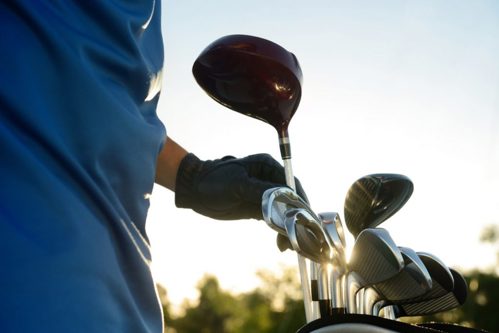
The loft and lie angle of your golf club has a major influence on how you launch the ball.
Every club is different in its loft and the way that they sit on the ground, so it’s essential that you get this right to suit your height and swing path, and to make sure that you’re giving yourself the best chance of finding the middle of the clubface, whatever the club is.
Loft and lie: drivers

Your driver will generally have around 10˚ of loft, but obviously, this can vary enormously, and players will tweak their drivers to try and optimise their distance. For example, Bryson DeChambeau has used a driver with as low a loft as 5.5˚.
Loft and lie: irons

With your irons, there will be around three or four degrees difference between each club, so each one will carry a different distance. Then, it’s a case of matching your woods and wedges, so you have even gaps to ensure you’ve got a club capable of hitting any distance you need.
What’s worth noting is that manufacturers will have different lofts on each club to suit the characteristics of said club. For example, a Ping G430 7-iron has a loft of 29˚, as this is a game-improvement iron designed to launch the ball high. On the other hand, Ping i230 irons, aimed at stronger players who don’t need as much help in getting the ball airborne, have a loft of 33˚ (on its 7-iron).
Generally speaking, the stronger the loft, the more swing speed (ball speed) is needed to launch the ball in the air.
Loft and lie: wedges and putters

Depending on what loft your pitching wedge is, you’ll then be looking to find the right number of wedges in those even gaps to make sure that you can cover any distance. Most wedges finish at around 58-60˚, but it is possible to play around with the lofts to really dial in your distances.
The putter has the least loft, but this is still a crucial factor in finding the middle of the face. The standard amount of loft on your putter is around 3-4˚, but again, it’s not a case of one-size-fits-all, and it’s all about how you deliver the club at impact.
Too much loft and the ball will get airborne, while too little loft and the ball will be hit into the turf. Both will have a big impact on your pace and distance control.
Club models

The model of your putter also matters. The Ping Anser has 3˚ of loft, which ties in with most Ping putters, but their Armlock putter, which is built with a longer shaft and grip, has a 6˚ standard loft.
If you play on quick greens, you might want to consider less loft as the ball will be rolling well, while for slow greens, you might want more loft. The best solution is to have a putter fitting—the results might surprise you.
The lie angle is the angle created between the shaft and the ground. This is crucial because if the lie angle is too flat, then the toe of the club will come into contact with the ground first. Conversely, if the lie angle is too upright, then the heel will dig in. Either way, the clubface will not be online, and you’ll see some crooked shots.
This is worth checking with a PGA professional or an experienced fitter, as you might be swinging the club perfectly, but if the club isn’t sitting correctly, your shots will be missing their target.
The centre of the sole of the clubhead should be touching the turf, and the grooves will be parallel to the ground. If the lie angle is too flat, the toe will hit the ground, which will open the clubface, and you’ll see the ball go right of the target. Likewise, if the lie angle is too upright, the heel will dig in, the clubface will close, and the ball will go left.
As a general rule of thumb, shorter golfers will often benefit from a flatter lie, while taller golfers might require more upright clubs. A good player might be able to manipulate what is happening with the lie angle, but the easiest way to make progress is to check your lies with a pro.
You’ll hear about lie angles with your irons and wedges, but they can also be important with your driver and fairways/hybrids, and there’s the option on adjustable clubs to play around with the lie angle.
Similarly, your putter’s lie angle is certainly something to get right. While we might know what the loft is on our driver, the chances are you won’t on your putter. The rule here is that if you like to stand close to the ball and you have a straight-ish putting arc, then a more upright putter will suit you. Alternatively, if you prefer a more curved arc, and stand further away from the ball, then a flatter lie angle will suit your stroke.
Checking your lofts and lies is a very easy way of improving your golf. Nowadays, there really is no reason to be playing with clubs that are doing you more harm than good (at least from this perspective), so it’s worth getting them looked at once a year at least.
Specialist golf insurance with Golf Care
Once your loft and lie are sorted, you may also want to consider protecting yourself and your golf equipment with specialist golf insurance.
With Golf Care, policies include Equipment Cover up to £7,500 and Public Liability up to £10m, so you can play golf with peace of mind.
Click on the banner below to learn more and get an online quote.
Please note the information provided on this page should not be taken as advice and has been written as a matter of opinion. For more on insurance cover and policy wording, see our homepage.
Get a quick quote for Golf Insurance
Get A Quote